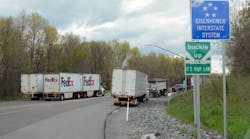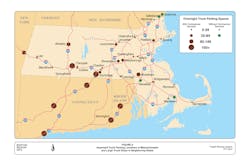The large commercial truck stop is the most important building block of the national rest stop location system. With electronic logging devices (ELDs) now keeping tabs on all drivers hours of service (HOS) there is an even greater need for more truck parking.
That was one of the key findings in a study by the Boston Region Metropolitan Planning Organization, according to the Bill Kuttner, a senior transportation analyst for the group. The Boston area, like many other metropolitan areas around the nation, is lacking in enough adequate, safe parking for trucks.
With fewer official parking spaces available in large metro areas such as Boston, more and more drivers are basically forced to park illegally – or in unofficial parking locations such as along highway exit and entrance ramps or in unmarked parking lots or road shoulders.
"Public rest areas on express highways contribute little to the truck driver rest location system because of factors such as small size, poor condition, or not being located on a key long-distance corridor," Kuttner said recently during a U.S. DOT webinar, "Talking Freight: Best Practices in Industry and Government Coordination for Developing Truck Parking Solutions."
While adding or expanding commercial truck stops is an obvious solution – it isn't an easy one. Kuttner talked about how many municipalities scoff at the idea of hosting more truck parking in the crowded Northeast. And the high prices of land in the Boston area also make it difficult to acquire the land or make it profitable.
"The need to assemble a substantial amount of land often leads commercial truck stop developers to acquire inexpensive land at some distance from areas where existing or prospective development have already caused real estate prices to rise," he said. "Furthermore, residents and businesses in existing developed areas may not be amenable to a new truck stop as a neighbor, even if land is available that the truck stop developer is able to purchase."
The northwest arc of I-495, "a vital long-distance freight corridor," Kuttner said, threads its way through suburbs in metro Boston. "This means higher land prices," he said, "the scattered presence of high-tech companies better reflects the type of land use that the communities are encouraging."
The section of I-495 between I-290 and US Route 3 has the greatest number of trucks of any express highway in Massachusetts, according to Kuttner's findings. In addition to those trucks engaged in regional distribution, it is also the direct corridor connecting the middle-Atlantic states and lower New England with upper New England and the Canadian maritime provinces. From the west and south, this corridor collects out-of-state traffic from Interstates 90, 84, and 395, and delivers this traffic to New Hampshire via US Route 3 and Interstates 93 and 95. Both government and industry stakeholders have cited this corridor as lacking adequate official truck parking
"But good design and new technologies can materially lessen the real and perceived negative impacts of a commercial truck stop," Kuttner later said.
Truck operations entail some level of unavoidable negative environmental impacts because of their size and power, he noted. "Even modern freight vehicles in full compliance with applicable regulations will have significantly more noise and emissions than light vehicles, such as autos that meet the emissions standards of their vehicle class."
Kuttner likes the idea of truck stop electrification (TSE), which includes installing a 120-volt household current at designated truck parking spaces at truck stops. "Some systems also have individual air conditioners at equipped parking spaces that may be attached to cabs through flexible conduits. Truck operators pay for these services on a per-hour basis," he said.
But implementing TSE at existing truck stops is not easy. It can require reconfiguring parking space layout and vehicle circulation, Kuttner noted. "User fees will not necessarily cover these investments," he said. "So public financial support or TSE as a required condition for receiving approval from planning authorities is sometimes required for TSE implementation."
The most successful truck stops, he said, are those that do not charge for truck parking during mandatory driver breaks but offer lots of amenities at the rest stop. "They generate revenue through the sale of diesel fuel as well as of supplies and services, such as diesel emissions fluid, tire replacement, and vehicle weighing," Kuttner said. "Foodservice and convenience stores are also commonplace, and often attract customers in light vehicles as well."
Long-term economic growth, according to the Boston study, will continue to place increased demands on the motor freight system and associated rest location system. "Strengthening a network of large truck stops may offer the greatest potential to accommodate future motor carrier growth and reduce the practice of unofficial truck parking," Kuttner said.
A truck rest location system
A long-distance truck driver, whether serving a location in Massachusetts or passing through the state, Kuttner said, wants to have an efficient trip that complies with both HOS regulations and customer delivery windows. "Some drivers have a regular itinerary and schedule, and a trip plan may be optimized for the repeated travel pattern," he said. "Other drivers are traveling to unfamiliar destinations in New England or from distant origins, so the time of entry into Massachusetts can only be estimated at the beginning of the trip."
Whether the trip is routine or it is the driver’s first time, Kuttner said, using the Boston area example, "the efficiency and safety of the trip may be enhanced by well-situated rest locations and associated amenities. Drivers with a regular itinerary will be familiar with the available rest locations and amenities and this knowledge will inform a standard trip plan. Drivers executing a new trip plan, as well as those who may be modifying it over the course of a long journey, need to understand their rest location options as they enter an unfamiliar region."
Publications such as Trucker's Friend list truck parking locations across the country. And a recent plan by a group of Midwest states will start listing available truck parking spaces on live road signs along major freight corridors this fall.
Kansas, Iowa, Minnesota, Wisconsin, Michigan, Indiana, Ohio and Kentucky teamed up to implement this regional truck parking system, which is currently under construction in all eight states. When completed, the Truck Parking Information and Management System (TPIMS) will cover more than 150 monitored parking sites on the high-volume highways for freight: I-35, I-39, I-64, I-65, I-70, I-71, I-75, I-80, I-94, I-135, and U.S. Route 33 in Ohio.
That information isn't limited to highway signs. It will also be made available, as open source, to smartphone apps, telematics companies, travel information websites and more.
In Massachusetts, Kuttner said that the commonwealth's transportation infrastructure investment program may be able to help solve its parking problems, particularly along I-495, by identifying and procuring suitable land. The recently enacted 2015 federal transportation authorization, FAST Act, permits federal funds to be used to improve and expand the truck rest location system.
If MassDOT, possibly with federal participation, purchases an appropriate site, it would be able to structure a long-term lease with a commercial truck stop operator who would build a truck stop subject to requirements that would ensure benefits to both Massachusetts and the motor freight industry, while mitigating both real and perceived negative impacts.





